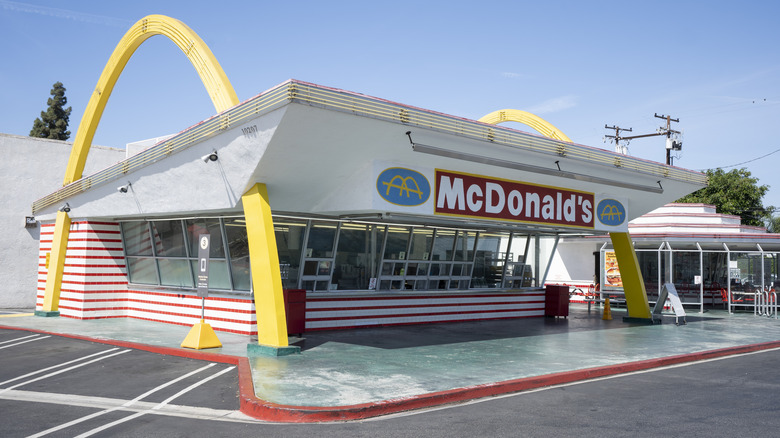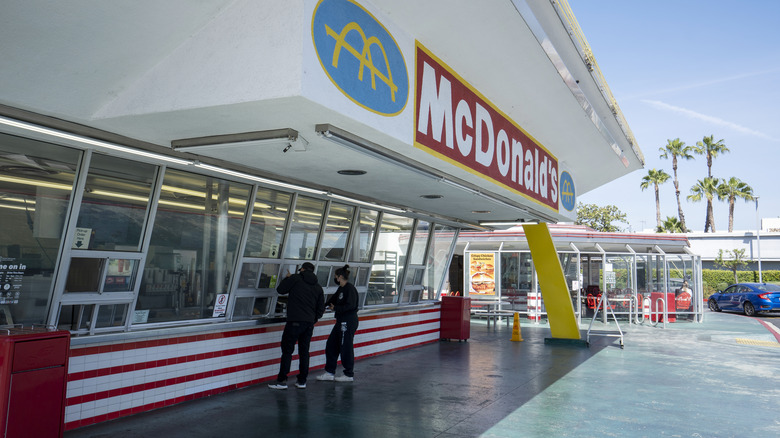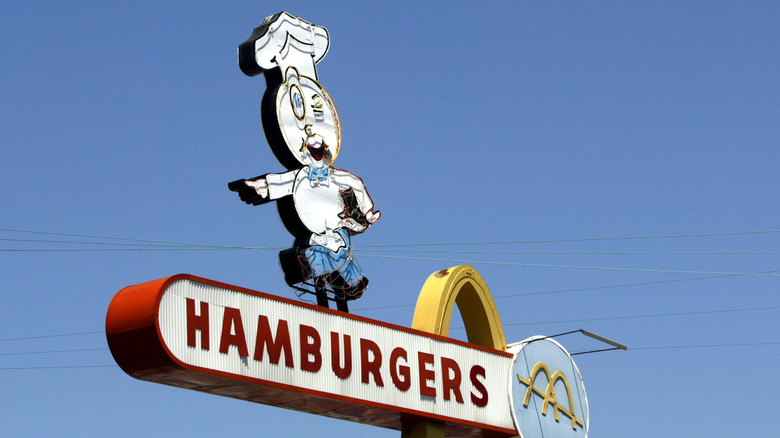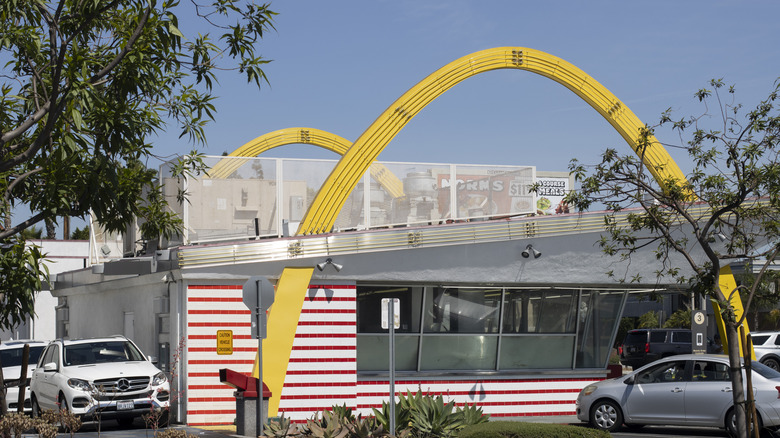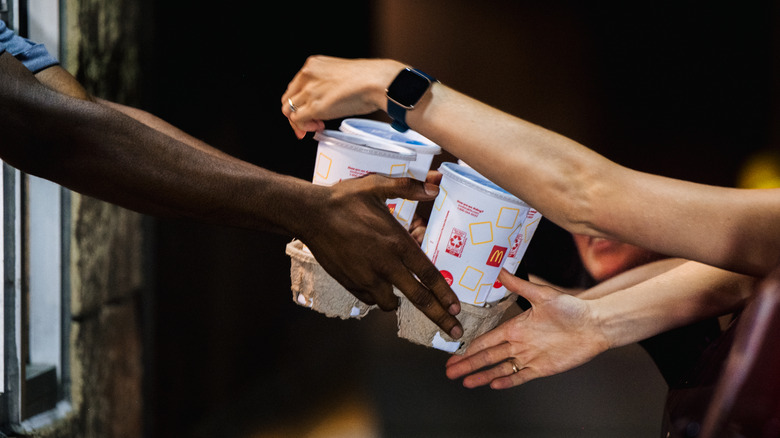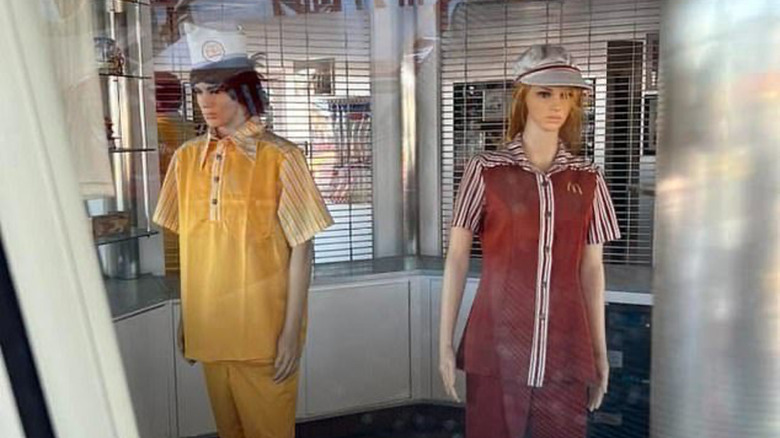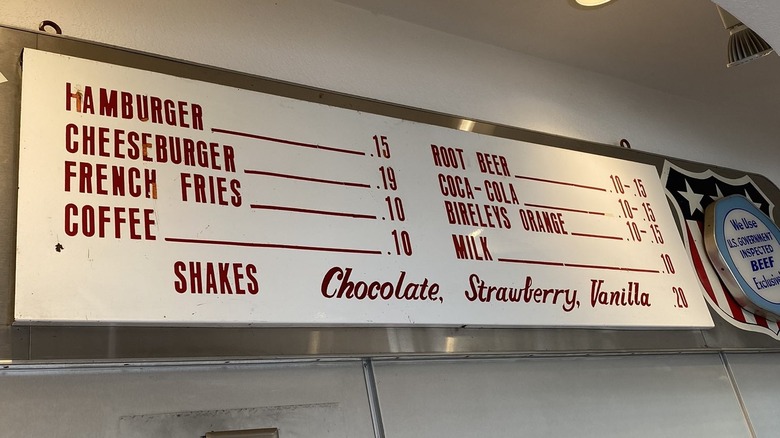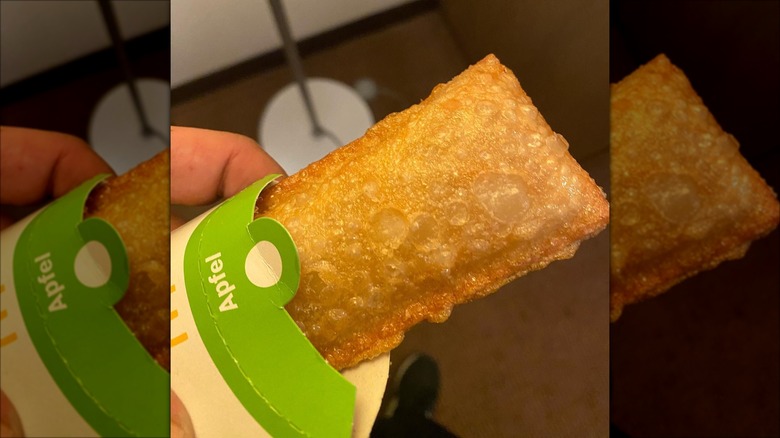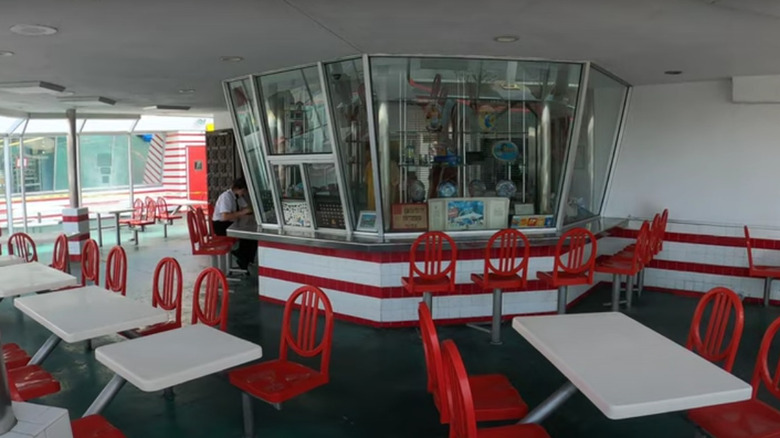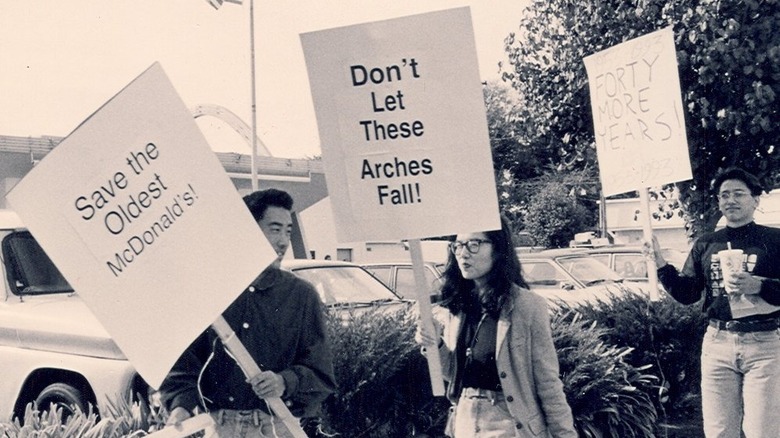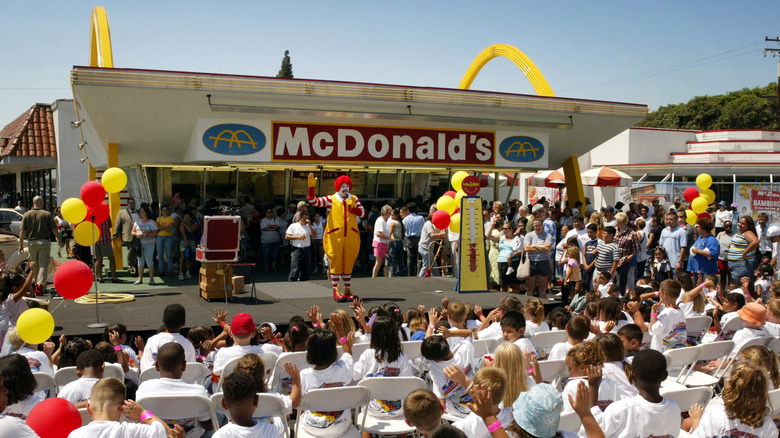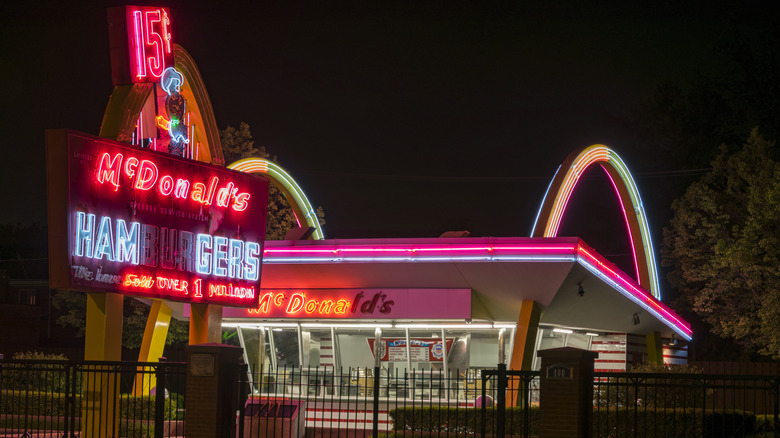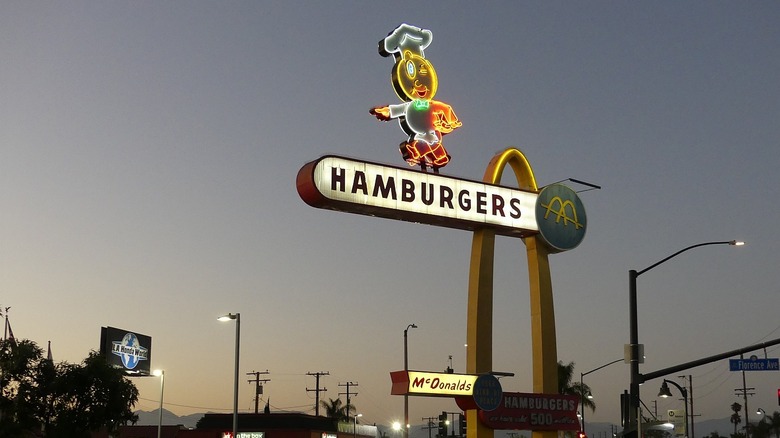What The World's Oldest McDonald's Looks Like Today
McDonald's is a franchise with a history that extends back more than 80 years, beginning in 1940 when brothers Richard and Maurice McDonald opened their first restaurant in San Bernadino, California. Back then, the restaurant was your classic drive-in, with carhops running food out to customers. The main menu item wasn't the Big Mac, however. Instead, it was barbecue, with more than 40 items of smoky deliciousness up for sale. The only problem was the barbecue wasn't selling.
Eventually, the brothers realized that customers were coming in primarily for burgers and decided to switch tracks. They dropped barbecue from the menu and turned McDonald's into a classic hamburger stand, offering burgers, fries, and Coca-Cola at insanely competitive prices. Adopting an assembly line-style approach to food service, the brothers began churning out meals faster than any of their competitors.
The change in direction proved to be successful, and the revamped restaurant was an almost overnight success. As the McDonald's brand grew in popularity, the brothers began to broaden their horizons, opening another location on Lakewood Boulevard in Downey, California, about 15 miles south of downtown Los Angeles. The San Bernadino location is now gone, but the L.A.-adjacent location still stands, making it the oldest active McDonald's on the planet. Here's what it's like to step inside the time warp of the world's oldest operating Mickey D's.
It's a '50s throwback
In 1961, former milkshake mixer salesman Ray Kroc bought out the McDonald brothers to bring the brand nationwide. His expansion and eventual domination of the world of fast food made McDonald's a household name. However, as Kroc grew his business empire, the Downey location fell outside of his purview. That location was owned by Roger Williams and Burdette Landon, who had purchased the rights directly from the McDonald brothers. As a result, the Downey location was free from the perpetual upgrades required of other McDonald's franchises and still looks essentially the same as it did back in 1953.
Walking through the Downey McDonald's is like stepping through a portal in time and coming out into the bright, blazing sun of the California of old. Red and white tiling adorns the walls, the roof and walk-up window sport the distinctive angular design that typified mid-20th century Americana, and the original golden arches still glow in neon when the sun goes down. You can almost picture customers lining up to enjoy burgers and shakes while Elvis Presley, Bill Haley, and The Four Aces blast from car stereos.
The original McDonald's mascot is still there
Long before Ronald McDonald became the face of McDonald's, the franchise was represented by Speedee, a cartoon chef with a burger for a head. The mascot's name was inspired by the "Speedee Service System," the McDonald brothers' patented method of preparing and delivering burgers to their customers quickly and efficiently. It ensured that burgers could be mass-produced and delivered quickly to eager customers with little to no wait time. This system is part of what helped push McDonald's to the forefront of the fast food revolution.
Speedee remained the face of the franchise until 1962 when he was phased out in favor of the clown mascot Ronald McDonald. Dubbed "The Hamburger-Happy Clown," Ronald McDonald began appearing in commercials in 1963, where he was first portrayed by TODAY weatherman Willard Scott. This iteration saw the mascot sporting a fast food tray as headgear and a paper cup in place of the classic red clown nose.
The character's popularity skyrocketed and so he became the franchise's mascot for more than 50 years. In 2016, due to a rise in creepy clown sightings around the country, Ronald McDonald was shelved by the brand, although the door is always open for a return. As for Speedee, the famous burger-headed chef can still be seen zipping about at a few Mickey D's locations, including one in Green Bay, Wisconsin, (open since 1959), at the oldest operating location in Downey, and at a couple of outlets in Florida.
It's the home of the classic Golden Arches
The Golden Arches are the defining symbol of the McDonald's brand and are recognized the world over. In fact, they are so famous that original research conducted by Sponsorship Research International reported that the arches were more well-known than the Christian cross (via Tampa Bay Times). Today, the two arches are joined to form the letter "M," but, in 1952, the arches were designed to make each location distinctive and eye-catching. The brainchild of Maurice "Mac" McDonald, the arches were designed by Stanley Clark Meston, a Los Angeles-based architect whose streamlined designs helped define the look of many drive-in restaurants during the 1950s.
The location in Downey was the second McDonald's to feature a distinctive design with arches on either side of the building. Today, very few buildings remain with this look, in part because of the franchise updates required by McDonald's that require the now-distinctive double arch logo. One such old-school spot is in San Jose and another is in Pomona, although it now operates as a doughnut shop. If you're looking for the classic, 1950s Mickey D's experience, the Downey spot is still your best bet.
Until recently, you couldn't drive through
The drive-thru is a McDonald's tradition that accounts for close to 70% of the company's business as of 2022. The concept originated in the '70s when soldiers stationed at Arizona's Fort Huachuca Army Base were unable to frequent the local McDonald's due to regulations stating that soldiers could not leave their vehicles while dressed in fatigues. Not wanting service members to be deprived of Big Macs, the company put in a sliding window at the local McDonald's and a revolution was soon born.
Although the drive-thru window has become a McDonald's staple, the classic location in Downey made it close to 60 years without one. Unfortunately for the restaurant, while this architectural omission may have added to its retro charm, it was also hurting sales. In 2016, the restaurant went before the city's Planning Commission to request approval for a drive-thru on the site. The lack of a drive-thru, combined with the placement of another McDonald's just down the street was impacting the viability of the throwback location.
The big question was where to place the window, while still preserving the integrity and history of the original structure. Eventually, the request was approved, with the decision being made to stash the window in an alley behind the building. Today, motorists looking to get their nostalgia on while also getting a fast food fix won't even have to leave their cars.
Check out the McDonald's museum while you're there
When you visit the Downey McDonald's, the restaurant isn't the only place where you can get a blast of nostalgia. There is also a small museum on site that features an array of McDonald's-themed items, including classic cups, Happy Meal toys from past eras, classic ads, and even one of the original costumes from the franchise's now-iconic "Mac Tonight" ad campaign from the '90s. As a cool bonus, the entrance to the museum incorporates the massive wooden doors from the original Hamburger University, the McDonald's training facility in Grove Village, Illinois. The brainchild of Ray Kroc, Hamburger University is a management training program that teaches franchisees the ins and outs of running a McDonald's.
If McDonald's history is your thing, you can also head north to San Bernadino, where the very first McDonald's opened in 1940. When Ray Kroc bought McDonald's from Ray and Maurice McDonald, the brothers failed to retain the rights to the name and were forced to rename their original stand to "The Big M." The location eventually closed and was demolished in 1972, but an unofficial museum still stands there. Here you can find the restaurant's original barbecue menu, newspaper articles chronicling the restaurant's rise, and a replica of the classic and time-saving ketchup gun that the McDonald brothers innovated.
Marvel at the original prices
One of the interesting features of the museum is an original menu board from the '50s, showing the unbelievably low prices that helped set McDonald's apart from the competition. If you rolled up to this McDonald's (or any other McDonald's location) back in 1953, a burger would cost you only 15 cents. Adding cheese would bump your bill up to a whopping 19 cents.
The reason that the McDonald brothers could keep prices so low is that their Speedee Service System kept the restaurant's overhead costs to a minimum. With paper cups and wrapping paper eliminating the need for dishwashers and a small, 12-person crew that worked assembly-line style, the McDonald brothers were able to keep their kitchen running smoothly and quickly without a large staff. All of this meant that, back in the day, if you decided to order yourself a cheeseburger, fries, and a large Coke, you'd be out a whole 44 cents. Not a bad deal for under a buck.
You can still order a deep fried apple pie there
Debuting in 1968, the deep-fried apple pie became as vital a component of the Mickey D's menu as French fries and the Big Mac (which also debuted the same year). However, after a run of nearly a quarter century, the franchise retired the fried pies in 1992, replacing them with a less-fatty baked alternative to appease growing public demand.
The loss of the deep-fried apple pie led many of the McDonald's faithful to search far and wide for any franchise holdouts that still featured the delicious treat on the menu. Until recently, restaurants in Miami and Tampa Bay still had them on the menu, but no more. This means that, as of 2023, the Downey location is likely the only McDonald's in the continental United States where you can still savor a crispy, deep-fried apple pie just like in the old days (some international locations still serve these treats, too). If you're feeling adventurous, you can also travel to Hawaii, where the fried apple pie is still a mainstay at all McDonald's locations in the Aloha State.
Seating is minimal
For a while in the late 20th century, one of McDonald's biggest bones of contention, at least regarding the restaurant in Downey, is the fact that, unlike its other franchise locations around the world, there was no indoor seating. That was a holdover from its '50s burger stand origins. Yet the feeling of higher-ups was that the original location, in its then-current state, was not at all equipped to meet the demands of the '90s McDonald's enthusiast. More to the point, the lack of an indoor dining room was hampering the restaurant's efforts to become profitable.
Luckily, the voices of the preservationists won out and kept the restaurant from being demolished. However, that didn't mean that a compromise couldn't be reached. As part of the restaurant's renaissance, the chain opened up a museum adjacent to the original stand, which features a modest indoor dining area. Today, visitors to the restaurant in Downey can take their food over to the museum, enjoy a meal in the indoor dining area, and then wander through 80 years of McDonald's history. That's pretty much a win any way you look at it.
The restaurant almost didn't survive
In 1994, Los Angeles was hit with an earthquake that registered 6.7 on the Richter scale, costing the city close to $20 billion in damage. Another $40 billion racked up as a result of economic loss, according to the California Department of Conservation. Among the buildings affected by the quake was the Downey McDonald's location. To many who had already fought to keep the location preserved in its original 1950s splendor, this seemed to be the final nail in the restaurant's coffin.
The corporate heads at McDonald's had long sought to close the restaurant, saying that renovations to modernize it would prove too costly. When the earthquake shuttered the restaurant indefinitely, this seemed to be the moment for McDonald's to finally lower the boom and tear the location down. However, the city came through at the last minute, refusing to issue a permit for McDonald's to demolish the restaurant, just days before the wrecking ball was about to strike. The Downey McDonald's eligibility to land on the National Register of Historic Places meant that architects had to evaluate the structure before it could be altered or torn down. Ultimately, the site was saved and reopened intact in 1996.
It wasn't owned by McDonald's Corporation until 1990
Although it's operated under the McDonald's name since 1953, the Downey restaurant was owned by Roger Williams and Burdette Landon, who purchased their franchise location directly from the McDonald brothers. When Ray Kroc took over as head of the company in 1961, Williams and Landon were still able to hold on to their restaurant. While this proved to be advantageous for the location in terms of keeping its integrity and original design, it also made it difficult for the owners to keep up with the competition.
Because Williams and Landon didn't pay a franchise fee to McDonald's, they weren't able to use such staples as mascot Ronald McDonald or serve otherwise ubiquitous items like Chicken McNuggets, Big Macs, or Happy Meals. Then, to make matters worse, another McDonald's location opened up just down the street, further cutting into their shaky profits. Eventually, flagging sales led Williams and Landon, by then well into their 80s, to finally sell the location to the McDonald's Corporation in 1990.
Another historic McDonald's location was demolished twice
When Ray Kroc began expanding the reach of McDonald's across America, the first place he planted his flag was in the Chicago suburb of Des Plaines, Illinois. Opened in 1955, the site was often referred to as the "Original McDonald's," given its status as the beginning of the franchises' expansion. However, for those keeping score, it's the ninth overall location.
Upon Kroc's death in 1984, the Des Plaines McDonald's was torn down. However, the company still wanted to preserve its history, so it built a replica restaurant on the site. Dubbed the McDonald's #1 Store Museum, the site was a lovingly-recreated replica of a classic, '50s-era Mickey D's, with mannequins dressed in old-school clothes, red and white tile, and classic milkshake machines. Unfortunately, flooding in the late 2000s forced the site to close, forcing passers-by to simply gaze through the windows. Eventually, it was deemed unsalvageable and the replica restaurant was torn down in 2018.
Even the Downey location's sign is iconic
When one thinks of McDonald's, they tend to think of the Golden Arches — plural. However, while the first McDonald's buildings sported two arches on either side that eventually morphed into the "M" shape we know today, the first signs featured just one arch. While most McDonald's locations around the globe now employ the double arch "M" logo, there are still a few locations around the U.S. that feature the single arch. One of these is in Downey, California.
Spotting a single arch McDonald's in the wild has become something of a quest for armchair Mickey D's historians, who either actively road trip in search of them or frantically pull over to post a sighting to social media. If you're trying to amass your collection of single-arch McDonald's shots, it's best to keep your car gassed up. They can be found in a wide range of diverse locations, ranging from Green Bay, Wisconsin to Pine Bluff, Arkansas. However, the location in Downey, California is a good place to check off a lot of McDonald's nostalgia boxes in just one visit. Plus, you can order a Big Mac and walk away with some sweet souvenirs to boot. So, what we're saying is, there's no real downside.
[Featured image by Didier Duforest via Wikimedia Commons | Cropped and scaled | CC BY-SA 4.0]
